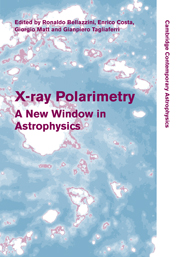Book contents
- Frontmatter
- Contents
- List of contributors
- Preface
- 1 X-ray polarimetry: historical remarks and other considerations
- Part I Polarimetry techniques
- Part II Polarized emission in X-ray sources
- Part III Future missions
- 37 Gravity and Extreme Magnetism SMEX (GEMS)
- 38 Programs of X-ray polarimetry in Italy
- 39 A polarimeter for IXO
- 40 Polarimetry with ASTRO-H soft gamma-ray detector
- 41 The Energetic X-ray Imaging Survey Telescope and its polarization sensitivity
- 42 PoGOLite: a balloon-borne soft gamma-ray polarimeter
- 43 Studies of neutron background rejection in the PoGOLite polarimeter
- 44 Observing polarized X-rays with PoGOLite
- 45 Pre-flight qualification tests of the PoGOLite detector system
- 46 The Gamma-RAy Polarimeter Experiment (GRAPE) balloon payload
- 47 POLAR: an instrument dedicated to GRB polarization measurement
- 48 Polarization detection capability of GRIPS
- 49 X-ray and γ-ray polarimetry small-satellite mission PolariS
- 50 GAP aboard the solar-powered sail mission
- 51 Hard X-ray polarimeter for small-satellite missions
- 52 Performance of hard X-ray polarimeter: PHENEX
- 53 GRB polarimetry with POET
- Author index
- Subject index
52 - Performance of hard X-ray polarimeter: PHENEX
from Part III - Future missions
Published online by Cambridge University Press: 06 July 2010
- Frontmatter
- Contents
- List of contributors
- Preface
- 1 X-ray polarimetry: historical remarks and other considerations
- Part I Polarimetry techniques
- Part II Polarized emission in X-ray sources
- Part III Future missions
- 37 Gravity and Extreme Magnetism SMEX (GEMS)
- 38 Programs of X-ray polarimetry in Italy
- 39 A polarimeter for IXO
- 40 Polarimetry with ASTRO-H soft gamma-ray detector
- 41 The Energetic X-ray Imaging Survey Telescope and its polarization sensitivity
- 42 PoGOLite: a balloon-borne soft gamma-ray polarimeter
- 43 Studies of neutron background rejection in the PoGOLite polarimeter
- 44 Observing polarized X-rays with PoGOLite
- 45 Pre-flight qualification tests of the PoGOLite detector system
- 46 The Gamma-RAy Polarimeter Experiment (GRAPE) balloon payload
- 47 POLAR: an instrument dedicated to GRB polarization measurement
- 48 Polarization detection capability of GRIPS
- 49 X-ray and γ-ray polarimetry small-satellite mission PolariS
- 50 GAP aboard the solar-powered sail mission
- 51 Hard X-ray polarimeter for small-satellite missions
- 52 Performance of hard X-ray polarimeter: PHENEX
- 53 GRB polarimetry with POET
- Author index
- Subject index
Summary
In order to measure precisely the polarization of Crab Nebula and Cygnus X-1, we have been developing a hard X-ray polarimeter for balloon-borne experiments called PHENEX (Polarimetry of High ENErgy X-rays). It consists of several detectors called unit counters. The unit counter has a detection efficiency of 20% and a modulation factor of 53% at 80 keV. Up to now, we have finished the installation of eight unit counters to the polarimeter, that will be launched in Spring 2009 to observe the Crab Nebula. If the polarization of this source is more than 30%, the PHENEX polarimeter will be able to measure the degree and the direction of the polarization with errors less than 10% and 10°, respectively.
Introduction
X-ray astronomy has been much advanced by three observations: spectroscopy, timing, and imaging. Also in the hard X-ray region, these three observations will be realized by ASTRO-H and XEUS. However, the observation of the polarization is at the moment left out in spite of its potential usefulness. This is because of the difficulty of developing polarimeters with high sensitivity. Since the origin of the polarization is often due to nonthermal radiation processes such as synchrotron radiation, observations in the hard X-ray region are possibly more important than those in the soft X-ray region: it is expected that the degree of polarization in the hard X-ray region would be higher than that at lower energies.
- Type
- Chapter
- Information
- X-ray PolarimetryA New Window in Astrophysics, pp. 350 - 354Publisher: Cambridge University PressPrint publication year: 2010



